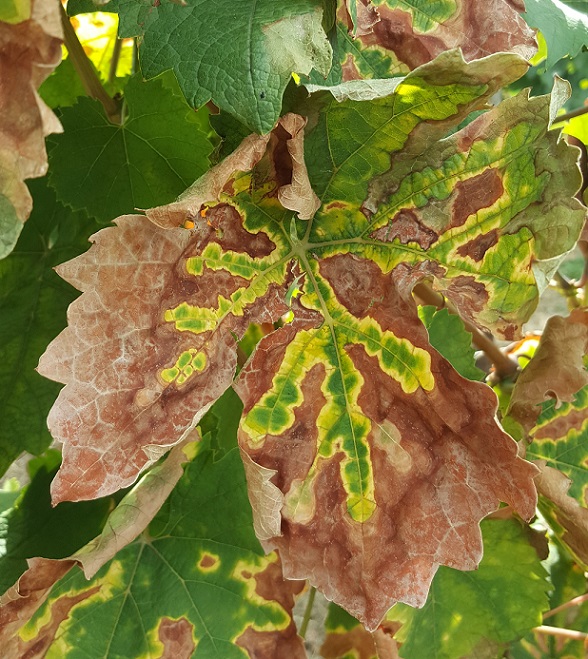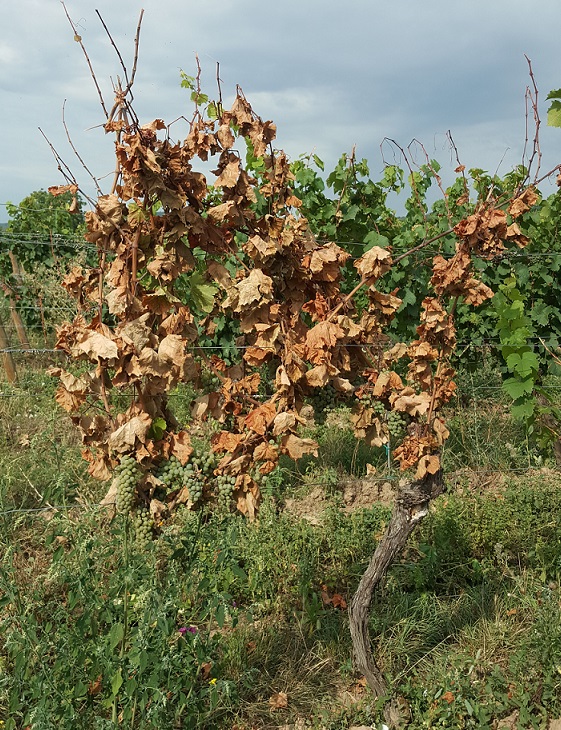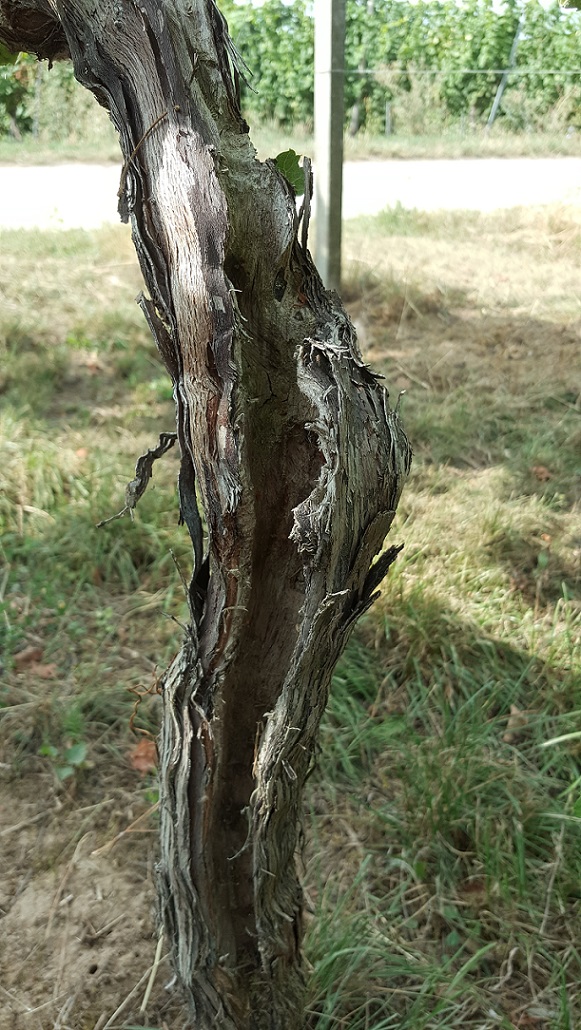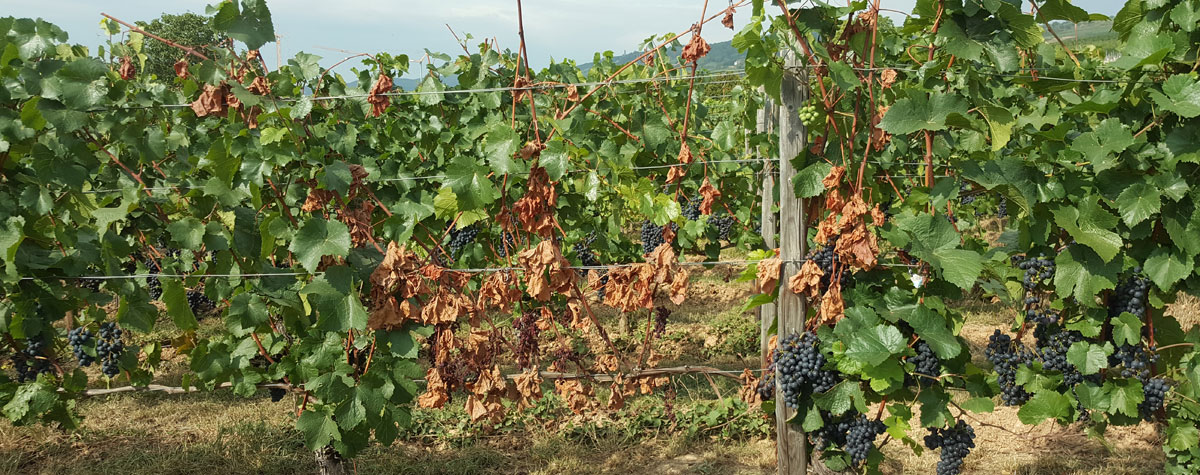History and economic importance
Esca, a grapevine trunk disease, is increasing in incidence and severity within vineyards and nurseries worldwide. It is a disease complex (and sometimes known as esca-complex) since many pathogens (mainly fungi) are involved. However, the term esca is still commonly used.According to the International Organization of Vine and Wine, trunk diseases (especially esca) are causing serious damage. In Italy, depending on varieties, 8-19% of vineyards are infected (white grapes being more susceptible), while in France it’s 13% and Spain 10%. Esca disease is not new.
Esca symptoms were already described (on temple walls) by Romans in ancient times; however, only since the beginning of the 19th century has the disease been scientifically researched.

Esca is Latin for ‘tinder’, which is a dry, easily ignited material suitable to start fires since esca-infected vines were used for that purpose. Other grapevine trunk diseases are Eutypa and Botryosphaeria dieback, which are more relevant to vineyards in USA and Australia.
Disease symptoms
The disease goes by different names according to vine age, visible symptoms and viticultural regions. Brown wood streaking, Petri disease, young esca and esca proper, black measles, black goo, grapevine leaf stripe and apoplexy are different names describing esca-infected vines. Brown wood streaking (discolouration and death of vessels), mostly affecting rooted cuttings, occurs at a stage where the vine has no leaves. Petri disease (also known as black goo) attacks very young vines (from one year) and causes stunting of the vine completely or partially. Its main symptom is a dark, gummy, almost tarry substance (goo) that oozes from wood vessels when cut, hence the name.
Esca on mature vines has two forms: a chronic form that lasts for several years (although symptoms are not visible every year) and an acute form (apoplexy) that kills the vine within a few days. The chronic form is characterised by chlorotic or necrotic dark red (for red cultivars) or yellow (on white cultivars) stripes on leaves with only a narrow green stripe along the ribs taking a ‘tiger stripe’ appearance (see photo above).

The apoplexy form is regarded as a severe form of esca and is characterised by a sudden wilting of leaves and shrivelling/drying of grape clusters (above). This violent event occurs in midsummer (during berry development), particularly when dry, hot weather follows rainfall.
Young esca affects young (two- to three-year-old) vines. It exhibits the typical leaf symptoms of esca externally, and dark streaks internally. Characteristic spotting on berry skin, described as ‘black measles’ in USA, is also observed. In some regions, a different fungus invades the vine trunks (rarely the rootstocks) and causes white decay, where the wood is transformed into a spongy, friable, whitish-yellow mass. When this happens, the disease is called esca proper.
Infection routes and disease progress
Infection could result from wounds, especially those caused by winter pruning, removal of side-shoots and mechanical harvesting. The spores of esca pathogens penetrate mainly through pruning wounds, where spores released from infected dead wood during rainfall infect exposed fresh pruning wounds. The fungus/fungi progressively reach the trunk and reside there.Until now, esca fungi have never been isolated from leaves leading to the assumption that toxins that are transported in the xylem cause leaf symptoms. Wounds are most susceptible to infection in the first two weeks after pruning. According to some studies, the probability decreases from 77% to 10% if infection only occurs 12 weeks after pruning. In nurseries, the presence of esca pathogens have been confirmed in hydration tanks, grafting tools and the substrates used for callusing. Therefore, grafting is considered the major risk for potential transmission of fungi associated with esca disease.
Prevention and control
Esca has been long considered as an almost negligible weakness disease that could be controlled with fungicides. However, this problem has been exacerbated when sodium arsenite fungicides, the sole effective treatment, have been banned (carcinogenic and high toxicity to the environment). With the ban of sodium arsenite, the incidence of esca increased drastically and no grapevine variety, either cultivated or wild, has been shown to be resistant to esca. The most effective way against esca is to prevent infection.'The most effective way against esca is to prevent infection'Cultural methods are essential to limit the spread of inoculum by removing and burning branches, dead/dying vines and pruning wastes.
Another way is to choose the right time for pruning. Pruning during dry weather is important because the number of spores in the air is lower at this time. A late pruning during the dormant period (as close as possible to the budbreak) is recommended, as the wounds can heal faster in warm temperatures. Another way to limit infection probability is to choose a pruning method that leaves small wounds. In some cases, pruning wounds are immediately sealed or treated (by paints or pastes) after pruning.
Hot water treatment (50⁰C, 30 min) is normally used for disinfection of nursery propagating materials. However, grapevine varieties have different degrees of sensitivity to this method.

Curative methods are also used to save esca-infected vines or at least prolong their life. One of these methods is grapevine surgery, where the grapevine trunk is cut open using a chainsaw. Another smaller chainsaw is used to clean the trunk by removing dead/infected wood, leaving the trunk open to dry.
This method is widely used worldwide, especially in old vineyards. Another method is trunk renewal, where the trunk is cut back below infected wood until healthy/clean wood is visible. One of the suckers is trained up to become a replacement trunk.
What is new in esca research?
Many techniques are being tested to control the disease. One of these is trunk injection. Since fungi reside in the trunk, it is difficult for fungicides to reach them. Therefore, compounds with potential fungicidal effect are injected (using a drill and syringe) inside the trunk.Among these compounds are copper nanoparticles, hydrogen peroxide and lignin-coated nanoparticles loaded with a fungicide. Some promising results have been obtained, where symptomatic esca-infected vines stopped showing symptoms. However, only time can show/prove if these methods can be reliable in the long term.













.png)






